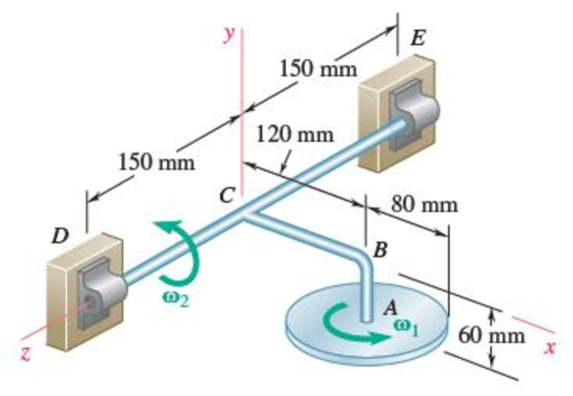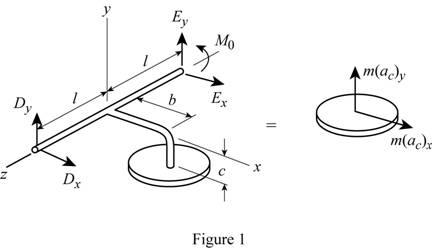
Concept explainers
A 2.5-kg homogeneous disk of radius 80 mm rotates at the constant rate ω1 = 50 rad/s with respect to arm ABC, which is welded to a shaft DCE. Knowing that at the instant shown, shaft DCE has an angular velocity ω2 = (12 rad/s)k and an angular acceleration α2 = (8 rad/s2)k, determine (a) the couple that must be applied to shaft DCE to produce that acceleration, (b) the corresponding dynamic reactions at D and E.

Fig. P18.103 and P18.104
(a)
The couple which must be applied to shaft DCE to produce that acceleration.
Answer to Problem 18.104P
The couple which must be applied to shaft DCE to produce that acceleration is
Explanation of Solution
Given information:
The mass (m) of the disk is 2.5kg.
The radius (r) of the disk Ais 80 mm.
The angular velocity
The angular acceleration
Calculation:
The angular velocity
Write the equation of angular velocity of disk A
Write the equation of angular velocity
Find the equation of angular velocity
Substitute 0 for
Find the equation of angular momentum about A
Here,
Substitute 0 for
Find the rate of change of angular momentum
Here,
Write the equation of vector form of angular velocity
Write the equation of the rate of change of angular momentum about A
Substitute
Write the equation mass moment of inertia
Write the equation mass moment of inertia
Substitute
Find the position vector
Here, b is the horizontal distance and c is the vertical distance.
Write the equation of velocity
Substitute
Write the equation of acceleration of the mass center A of the disk.
Substitute
Sketch the free body diagram and kinetic diagram of the system as shown in Figure (1).

Refer Figure (1),
Apply Newton’s law of motion.
Substitute
Equate i-vector coefficients in Equation (4).
Equate j-vector coefficients in Equation (4).
Find the rate of change of angular momentum about E
Here,
Substitute
Apply matrix multiplication,
Take moment about E.
Here,
The moment at E is equal to the rate of change of angular momentum at E.
Equate Equation (7) and (8).
Convert the unit of radius from mm to m.
Convert the unit of b from mm to m.
Convert the unit of c from mm to m.
Convert the unit of l from mm to m.
Find the couple
Equate
Substitute 2.5 kg for
Thus, the couple which must be applied to shaft DCE to produce that acceleration is
(b)
Find the corresponding dynamic reactions at D and E.
Answer to Problem 18.104P
The dynamic reaction at D is
The dynamic reaction at E is
Explanation of Solution
Calculation:
Find the component of dynamic reaction
Equate
Substitute 2.5 kg for
Find the component of dynamic reaction
Equate
Substitute 2.5 kg for
Find the dynamic reaction at D using the equation:
Substitute
Thus, the dynamic reaction at D is
Find the component of dynamic reaction
Substitute Equation (11) in (5).
Substitute 2.5 kg for
Find the component of dynamic reaction
Substitute Equation (12) in (6).
Substitute 2.5 kg for
Find the dynamic reaction at E using the equation:
Substitute
Thus, the dynamic reaction at E is
Want to see more full solutions like this?
Chapter 18 Solutions
Vector Mechanics for Engineers: Statics and Dynamics
- A 2.5-kg homogeneous disk of radius 80 mm rotates at the constant rate ω1 = 50 rad/s with respect to arm ABC, which is welded to a shaft DCE. Knowing that at the instant shown, shaft DCE has an angular velocity w2 = (12 rad/s)k and an angular acceleration a2= = (8 rad/s2)k, determine (a) the couple that must be applied to shaft DCE to produce that acceleration, (b) the corresponding dynamic reactions at D and E.arrow_forwardThe blade of a portable saw and the rotor of its motor have a total weight of 2.5 lb and a combined radius of gyration of 1.5 in. Knowing that the blade rotates as shown at the rate w1= 1500 rpm, determine the magnitude and direction of the couple M that a worker must exert on the handle of the saw to rotate it with a constant angular velocity w2= -(2.4 rad/s)j.arrow_forwardTwo uniform cylinders, each of mass m = 6 kg and radius r = 125 mm, are connected by a belt as shown. Knowing that at the instant shown the angular velocity of cylinder A is 30 rad/s counterclockwise, determine (a) the time required for the angular velocity of cylinder A to be reduced to 5 rad/s, (b) the tension in the portion of belt connecting the two cylinders.arrow_forward
- Two uniform cylinders, each of weight W = 14 lb and radius r = 5 in., are connected by a belt as shown. Knowing that at the instant shown the angular velocity of cylinder B is 30 rad/s clockwise, determine (a) the distance through which cylinder A will rise before the angular velocity of cylinder B is reduced to 5 rad/s, (b ) the tension in the portion of belt connecting the two cylinders.arrow_forwardTwo friction wheels A and B are both rotating freely at 300 rpm counterclockwise when they are brought into contact. After 12 s of slippage, during which time each wheel has a constant angular acceleration, wheel B reaches a final angular velocity of 75 rpm counterclockwise. Determine (a) the angular acceleration of each wheel during the period of slippage, (b) the time at which the angular velocity of wheel A is equal to zero.arrow_forwardThe upper and lower ends of the arms are pivoted on the axis of the governor has equal arms of length 44cm. The extension arms of the lower links are each 10cm long and parallel to the axis.When the governor at minimum and maximum position, the radii of rotation of the balls are 17cm and 24cm respectively. The mass of each ball is 10 kg and the mass of the central load is 102 kg. Determine : 1.The range of angular speed of the governor and identify the type of governor 2.Draw the line diagram when the governor at minimum and maximum positionarrow_forward
- Ring C has an inside radius of 55 mm and an outside radius of 60 mm and is positioned between two wheels A and B, each of 24-mm outside radius. Knowing that wheel A rotates with a constant angular velocity of 300 rpm and that no slipping occurs, determine (a) the angular velocity of ring C and of wheel B, (b) the acceleration of the points on A and B that are in contact with C.arrow_forwardIn the gear arrangement shown, gears A and C are attached to rod ABC, that is free to rotate about B, while the inner gear B is fixed. Knowing that the system is at rest, determine the magnitude of the couple M that must be applied to rod ABC, if 2.5 s later the angular velocity of the rod is to be 240 rpm clockwise. Gears A and C ABC weighs 4 lb.arrow_forwardEach of the gears A and B has a mass of 675 g and a radius of gyration of 40 mm, while gear C has a mass of 3.6 kg and a radius of gyration of 100 mm. Assume that kinetic friction in the bearings of gears A, B C produces couples of constant magnitude 0.15 N.m, 0.15 N.m, 0.3 N.m, respectively. Knowing that the initial angular velocity of gear C is 2000 rpm, determine the time required for the system to come to rest.arrow_forward
- Cylinder A is moving downward with a velocity of 3 m/s when the brake is suddenly applied to the drum. Knowing that the cylinder moves 6 m downward before coming to rest and assuming uniformly accelerated motion, determine (a) the angular acceleration of the drum, (b) the time required for the cylinder to come to rest.arrow_forwardA 1200-kg satellite designed to study the sun has an angular velocity of w0 = (0.050 rad/s)i + (0.075 rad/s)k when two small jets are activated at A and B in a direction parallel to the y axis. Knowing that the coordinate axes are principal centroidal axes, that the radii of gyration of the satellite are and that each jet produces a 50-N thrust, determine (a ) the required operating time of each jet if the angular velocity of the satellite is to be reduced to zero, (b ) the resulting change in the velocity of the mass center G.arrow_forwardA 5.32-kg disk A of radius 0.445 m initially rotating counter-clockwise at 436 rev/min is engaged with a 6.72-kg disk B of radius 0.275 m initially rotating clockwise at 528 rev/min, where the moment of inertia of a disk is given as I = ½ mi?. Determine their combined angular speed (in rpm) and direction of rotation after the meshing of the two disks. Remember to show clearly the equations that you use!!'arrow_forward
 Elements Of ElectromagneticsMechanical EngineeringISBN:9780190698614Author:Sadiku, Matthew N. O.Publisher:Oxford University Press
Elements Of ElectromagneticsMechanical EngineeringISBN:9780190698614Author:Sadiku, Matthew N. O.Publisher:Oxford University Press Mechanics of Materials (10th Edition)Mechanical EngineeringISBN:9780134319650Author:Russell C. HibbelerPublisher:PEARSON
Mechanics of Materials (10th Edition)Mechanical EngineeringISBN:9780134319650Author:Russell C. HibbelerPublisher:PEARSON Thermodynamics: An Engineering ApproachMechanical EngineeringISBN:9781259822674Author:Yunus A. Cengel Dr., Michael A. BolesPublisher:McGraw-Hill Education
Thermodynamics: An Engineering ApproachMechanical EngineeringISBN:9781259822674Author:Yunus A. Cengel Dr., Michael A. BolesPublisher:McGraw-Hill Education Control Systems EngineeringMechanical EngineeringISBN:9781118170519Author:Norman S. NisePublisher:WILEY
Control Systems EngineeringMechanical EngineeringISBN:9781118170519Author:Norman S. NisePublisher:WILEY Mechanics of Materials (MindTap Course List)Mechanical EngineeringISBN:9781337093347Author:Barry J. Goodno, James M. GerePublisher:Cengage Learning
Mechanics of Materials (MindTap Course List)Mechanical EngineeringISBN:9781337093347Author:Barry J. Goodno, James M. GerePublisher:Cengage Learning Engineering Mechanics: StaticsMechanical EngineeringISBN:9781118807330Author:James L. Meriam, L. G. Kraige, J. N. BoltonPublisher:WILEY
Engineering Mechanics: StaticsMechanical EngineeringISBN:9781118807330Author:James L. Meriam, L. G. Kraige, J. N. BoltonPublisher:WILEY





